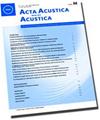Reconsideration on Helmholtz-Kirchhoff Integral Solutions for Boundary Points in Radiation Problems
Q1 Arts and Humanities
引用次数: 0
Abstract
The Helmholtz-Kirchhoff integral (HKI) formula is very useful when designing transducers because it can be used to predict the acoustic pressure of a radiator at any position given only the acoustic pressure and velocity of the source. Many studies have been carried out to determine how to predict the acoustic pressure distributions generated by radiator sources using the HKI formula and boundary conditions. However, if the surface integration process includes radiator edges or vertices, then it is difficult to predict a consistent acoustic pressure distribution accurately, and the precise HKI formula to solve this problem and rigorous derivation are not known. In this article, to overcome these limitations, a formulation of the HKI for the boundary is proposed. This formulation is based on intuitive considerations and proven mathematically. Using the proposed expression of the HKI formula for the boundary, the acoustic pressures radiated by irregular surfaces were calculated and compared with the distributions obtained by the finite element method and theoretically exact solutions. The results obtained with the proposed formulation of the HKI were confirmed to be more accurate than those of the conventional HKI formula.辐射问题边界点Helmholtz-Kirchhoff积分解的再思考
亥姆霍兹-基尔霍夫积分(HKI)公式在设计换能器时非常有用,因为它可以用来预测在给定声源声压和声速的任何位置上辐射器的声压。如何利用HKI公式和边界条件预测辐射源产生的声压分布,已经进行了许多研究。然而,如果表面积分过程中包含辐射体边缘或顶点,则难以准确预测一致的声压分布,并且不知道解决这一问题的精确HKI公式和严格的推导。在本文中,为了克服这些限制,提出了一种边界的HKI公式。这个公式是基于直觉的考虑和数学证明。利用提出的边界HKI公式,计算了不规则表面辐射声压的分布,并与有限元法得到的分布和理论精确解进行了比较。结果表明,所提出的HKI公式比传统的HKI公式更准确。
本文章由计算机程序翻译,如有差异,请以英文原文为准。
求助全文
约1分钟内获得全文
求助全文
来源期刊
CiteScore
2.60
自引率
0.00%
发文量
0
审稿时长
6.8 months
期刊介绍:
Cessation. Acta Acustica united with Acustica (Acta Acust united Ac), was published together with the European Acoustics Association (EAA). It was an international, peer-reviewed journal on acoustics. It published original articles on all subjects in the field of acoustics, such as
• General Linear Acoustics, • Nonlinear Acoustics, Macrosonics, • Aeroacoustics, • Atmospheric Sound, • Underwater Sound, • Ultrasonics, • Physical Acoustics, • Structural Acoustics, • Noise Control, • Active Control, • Environmental Noise, • Building Acoustics, • Room Acoustics, • Acoustic Materials and Metamaterials, • Audio Signal Processing and Transducers, • Computational and Numerical Acoustics, • Hearing, Audiology and Psychoacoustics, • Speech,
• Musical Acoustics, • Virtual Acoustics, • Auditory Quality of Systems, • Animal Bioacoustics, • History of Acoustics.

 求助内容:
求助内容: 应助结果提醒方式:
应助结果提醒方式:


